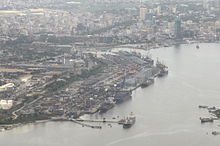Port of Dar es Salaam
| Dar es Salaam Port | |
|---|---|
 |
|
| Location | |
| Country | Tanzania |
| Location | Kurasini, Dar es Salaam |
| Details | |
| Operated by | Tanzania Ports Authority |
| Owned by | Government of Tanzania |
| Type of harbor | Natural |
| Available berths | 11 |
| Wharfs | 4 |
| Employees | 2,684 (2012) |
| Port Manager | (Seat Empty) |
| Channel depth | 12m |
| Statistics | |
| Vessel arrivals |
|
| Annual cargo tonnage |
|
| Annual container volume |
|
| Value of cargo |
|
| Passenger traffic |
|
|
Website www |
|
The Port of Dar es Salaam is the principal port serving Tanzania. The port is one of three ocean ports in the country and handles over 90% of the country's cargo traffic. According to the International Association of Ports and Harbors, it is the fourth largest port on the African continent's Indian Ocean coastline after Durban, Mombasa and Maputo. The port acts as a gateway for commerce and trade for Tanzania and numerous bordering landlocked states. For years the inefficiencies at the port has cost the regional economy millions of dollars; in 2012 the total global welfare loss caused by the inefficiencies of the port stood at US$1.8 billion for the Tanzanian economy and 830 million US dollars for the neighbouring countries.
The city of Dar es Salaam owes its existence to the port of Dar es salaam. The city began development in 1862 by the Sultan of Zanzibar Seyyid Majjid as an alternative port to the port of bagamoyo and zanzibar, however after his death the project was scrapped. It wasn't until the German East African Company began to rebuild the city in 1887. The Germans had already completed the Usambara railway from the Port of Tanga and began constructing the new Tanzanian Central Line from their new capital the port of Dar es Salaam.
After World War I the British took over Tanganika and maintained their capital in city. Economic activity continued through the early 20th century and through World War II centralized around the city and facilitated expansion of the port. After Tanganika gained its independence the city retained its position as the commercial capital.
...
Wikipedia
